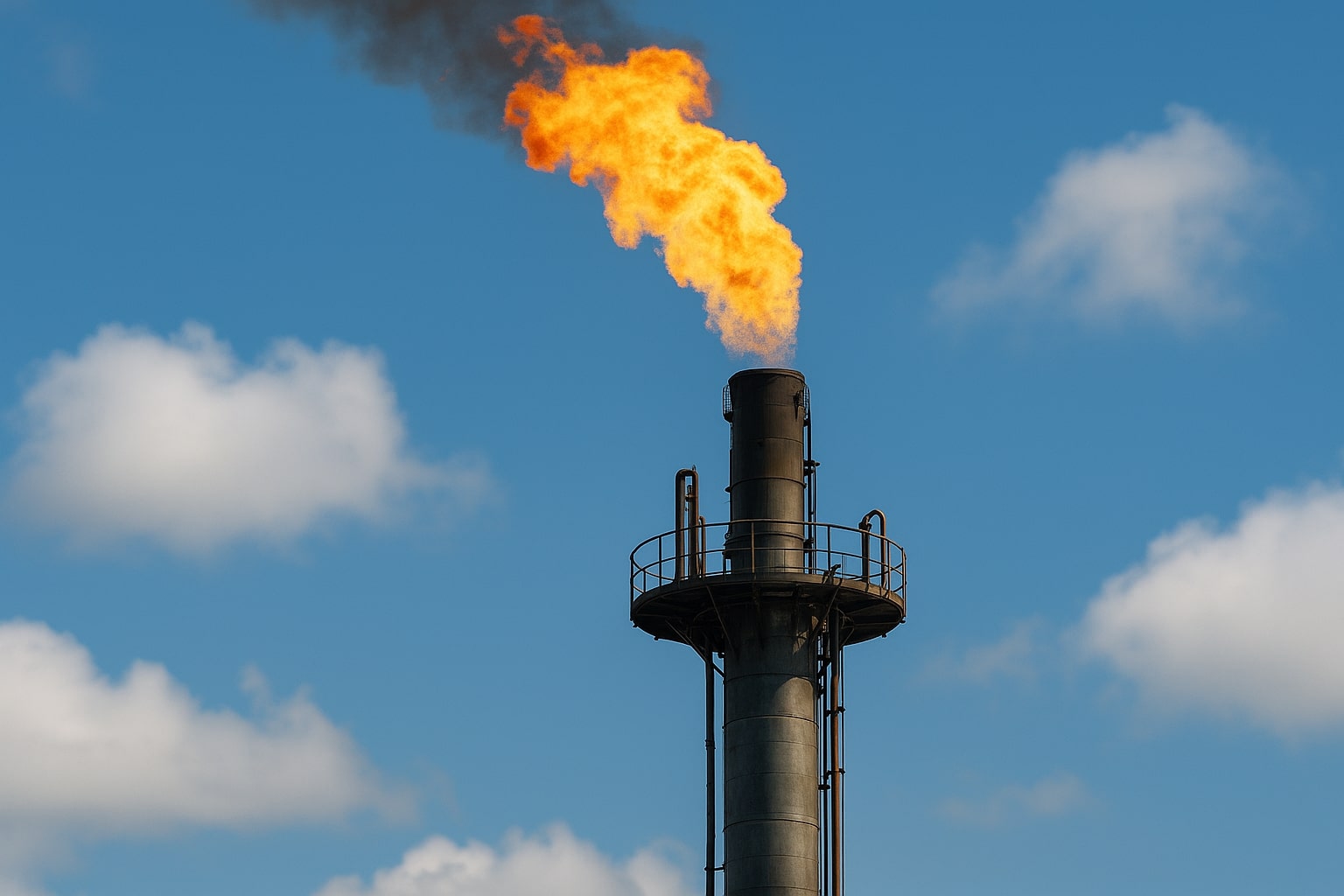
Natural Gas (NG=F) Breaches $3.52 as Storage Glut and Mild Weather Trigger Bearish Break
With U.S. inventories surging 96 Bcf and weather models skewing cooler, NG=F eyes a test of $2.885 unless $3.78 resistance is reclaimed | That's TradingNEWS
Natural Gas (NG=F) Slides Below $3.52 as Technical Breakdown Triggers Selloff
U.S. Natural Gas (NG=F) futures dropped to $3.520/MMBtu, breaching major support levels as bearish sentiment intensified. After collapsing through the April floor at $3.544, price action now eyes a downside test toward $2.885. This marks the third straight session of losses, with July contracts fading toward expiration and momentum caught between heavy speculative unwinding and broader macro weakness.
The break below the 200-day SMA at $3.777 triggered algorithmic selling, reversing a prior bounce off the 50-day EMA. Technical pressure is now layered at $3.544, $3.40, and the 200-day EMA at $3.40. Price currently struggles to hold above $3.50 amid persistent negative flows.
Bearish Fundamentals Reinforced by Elevated Storage and Mild Weather Patterns
The latest EIA report confirmed a 96 Bcf build in U.S. inventories for the week ending June 20, exceeding expectations of 88 Bcf and extending the supply surplus to 6.1% above the five-year seasonal norm. This marked the second consecutive weekly build above 95 Bcf, following the prior week's 95 Bcf injection.
Inventories now stand significantly above last year’s levels, with no immediate sign of tightening. Power generation demand has slipped 3.1% year-over-year, according to BNEF, while total U.S. dry gas production remains high at 105.9 Bcf/day (+2.9% y/y). Demand, in contrast, lags at 79.9 Bcf/day, worsening the supply-demand imbalance.
Forecasts for cooler weather into early July—particularly across the U.S. Midwest and East—have undercut expectations for summer-driven air conditioning demand. Wind output has also surged temporarily, offsetting gas-fired power demand.
LNG Exports Remain Robust, but Ceasefire Eases Global Risk Premium
Despite bearish U.S. fundamentals, LNG exports held firm at 14.7 Bcf/day, up 9.2% week-over-week, signaling continued global appetite. However, the Israel-Iran ceasefire has deflated geopolitical risk premiums previously baked into gas prices. With the Strait of Hormuz no longer under imminent threat, speculative hedges tied to LNG flow disruption have dissipated.
European gas storage sits at 54% as of June 16—below the five-year norm of 64%—yet the continent remains well-supplied in the near term. Mild weather and strong renewable output continue to dampen European LNG spot pricing, capping U.S. export margins.
Western Canadian Gas Market Diverges Amid Pipeline Bottlenecks and Surging Output
While U.S. gas prices falter, Western Canadian benchmarks like AECO and Westcoast Station 2 have plunged even further due to persistent pipeline congestion and record production exceeding 20 Bcf/day. Despite high expectations around LNG Canada, delays and mild spring weather flattened local demand. Westcoast Station 2 hit a multimonth low in late April, diverging sharply from Henry Hub prices.
Martin King of RBN Energy noted that Canada’s gas market remains structurally disadvantaged: robust supply without matching takeaway capacity. Traders continue discounting regional gas, waiting for infrastructure catch-up.
Volatility Resurfaces as NG=F Rallies Then Reverses Near $3.60 Resistance
On Thursday, NG=F opened with a gap higher, approaching $3.60 before rolling over again—underscoring the fragility of any upside retracement. The price rejected the 50-day EMA and reversed from a confluence of resistance including the 200-day EMA and rising wedge support near $3.40–$3.544.
This fade from $3.60 occurred despite a short-term spike in EIA energy consumption (+1% YoY), highlighting how weather and sentiment dominate the tape in June. Traders view any rallies toward $3.60 as selling opportunities unless a significant surprise in storage or heat arrives.
Rig Count and Electricity Output Offer Mixed Signals for Demand Recovery
The Baker Hughes gas rig count dipped by 2 rigs to 111, below the recent 15-month high of 114. While rigs have risen from last September’s low of 94, activity appears to be stalling near current levels.
Electricity output rose 0.8% y/y to 85,329 GWh in the latest week, per the Edison Electric Institute. For the past 52 weeks, generation grew 2.9% y/y. This provides some positive backdrop for gas burn recovery, though it remains too modest to offset the storage surplus.
Weather Models Weigh on Bullish Narratives Heading Into July Contracts
Forecasts for June 29–July 3 continue to skew cooler, especially across key demand zones. Atmospheric G2 expects below-average temps in the South and South-Central U.S., reducing peak power consumption. While short bursts of heat remain possible, they are not enough to alter the macro trend.
Commodity Weather Group sees a further cooling pattern into early July, weakening hopes for a weather-led rally. The market now braces for August to become the front-month contract, with weak technicals and heavy inventory pressuring the handover.
Technical Outlook: Break of $3.544 Confirms Bearish Bias Toward $2.885 Zone
The breakdown below $3.544 and the 200-day SMA locked in a bearish bias that has not yet reversed. Immediate resistance lies at $3.60, followed by heavier pressure near $3.78–$3.90. The key technical risk remains a breach below $3.40, which could accelerate selling toward $2.885—last seen in mid-February.
Only a combination of heatwave-driven demand and a bullish surprise in EIA storage could trigger a reversal. For now, RSI sits below 45 and MACD has crossed into negative territory. Traders remain defensive unless $3.78 is reclaimed with volume.
Short-Term Verdict: Hold With Bearish Skew Until $3.78 Reclaimed
Natural Gas (NG=F) remains in a structurally bearish setup with momentum favoring continued downside unless catalysts materialize. While fundamentals like LNG exports and electricity output show moderate strength, they are outweighed by oversized storage, mild weather, and broken support.
As long as prices remain under $3.78 and storage builds exceed 90 Bcf/week, a test of $2.885 is increasingly likely. However, extreme summer heat or a major shift in power demand could turn sentiment rapidly.
For now, the call is Hold, with a bearish tilt. Traders should monitor the $3.40–$3.50 band closely for signs of base-building. A close below $3.40 likely accelerates losses, while a breakout above $3.78 reopens bullish potential toward $4.20.
Price at publish: $3.520
That's TradingNEWS
Read More
-
SCHD ETF Price at $27: Can SCHD’s 4% Yield and 9.15% Dividend Growth Beat High-Yield Covered Call ETFs?
15.12.2025 · TradingNEWS ArchiveStocks
-
XRP ETFs Close on $1B Inflows as XRPI at $10.92 and XRPR at $15.52 Hit 52-Week Lows
15.12.2025 · TradingNEWS ArchiveCrypto
-
Natural Gas Price Forecast: NG=F Holds the $4 Floor as Oversupply Clashes with 2026 LNG Demand
15.12.2025 · TradingNEWS ArchiveCommodities
-
USD/JPY Price Forecast - Dollar to Yen At 155: Yen Strength Builds As BoJ Hike And NFP Collide
15.12.2025 · TradingNEWS ArchiveForex



















